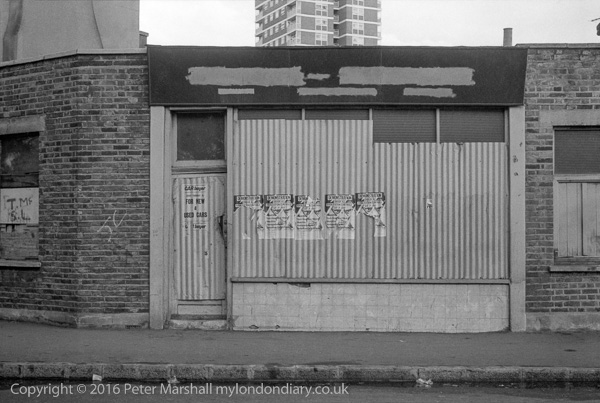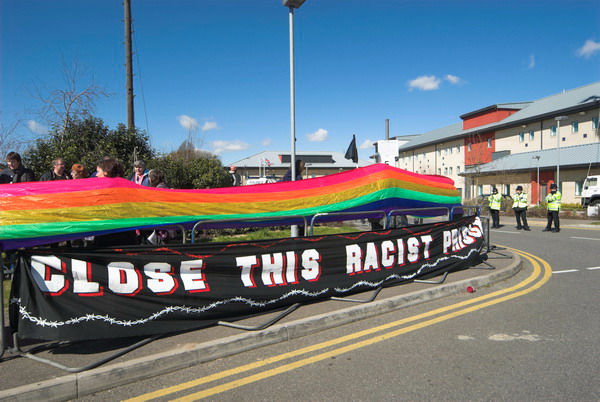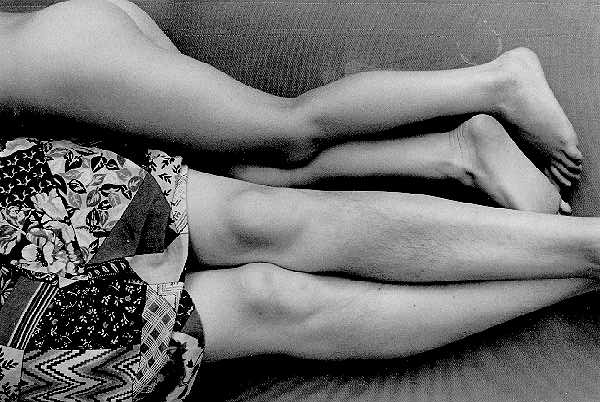I’m often surprised by the Internet, or rather I should say by the World Wide Web, invented by Tim Berners-Lee, whose name though etched in my memory I was unable to recall in a pub quiz last night to my extreme annoyance. Both by what you can find out using it, and sometimes by what you can’t.
Currently, as some will know, most days I post a black and white picture taken in London in 1979 on Facebook, with a usually short comment on the subject matter. All of the pictures are on my London web site, but currently there are only brief captions, as in today’s example:

Disused shop, Hackney, 1979
21l-66: shop,, derelict,
Back in 1979 I took relatively few photographs on often long and protracted walks and kept few records; for me then the photograph was the record, and it was only a few years later that I began to keep something of a diary of my walks and to annotate the contact sheets of my films with street names and grid references.
When I wrote the web page I only had a vague idea about where I made this image – somewhere close to London Fields and not far from Broadway Market. That I now know where it was taken to within a yard or two is thanks largely to Google Street View, and the two buildings in the background, both of which appear in other pictures of mine.
Street View of course has its limitations. Where this shop stood is now simply a brick wall, and Street View only allows limited time travel, usually back to 2008, when the shop was long gone. Its often impossible to get a view from exactly the place and angle you need, and it doesn’t share my predeliction for alleys and footways, with rare exceptions sticking to where a car can drive. It also has a very annoying habit of jumping inside shops where no-one wants to go, which greatly reduces its utility to the public if enriching Google from the owners of these premises.
But of course Street View is a remarkable asset, and one which has almost rendered some photographic projects unnecessary, as I commented in my 2014 post Bleeding London – re-Inventing Streetview? It’s a resource I now often use when planning walks and visits to new locations.
The time limitation isn’t just confined to Street View. Most of the material on the web has been put there in the last few years, and there is relatively little information about the times before it existed. Various projects have put considerable efforts into digitising historical material and putting local history research into web sites, but much published material from the last century is still unavailable, either not digitised or hidden behind paywalls. Of course much is still copyright, and will remain so until 70 years after the death of its authors, and as a photographer I welcome that (although I am considering gifting my own work to the public domain on my death.)
The posters across the front of the shop are for a march from Hounslow West Station to protest at Harmondsworth Detention Centre on Saturday 21st July. A calendar on the web for 1979 confirms that the 21st of July that year was a Saturday, so these posters, despite their condition, were fairly fresh when I photographed them, probably on the 22nd or 29th July 1979. But the small print at the bottom of them cannot be read, and I can find no record on the web about this demonstration.
I was surely interested about it when I took the photograph because I was living just a 20 minute bike ride from the immigration prison (I still live in the same place, but the bike ride takes me a little longer) and also because I grew up spitting distance from the starting point of the march. But probably taking this photograph would have been the first I had heard about the march. Before the web, this photograph illustrates how information about most protests was shared, by fly-posting. Leaflets were handed out at other protests – as they still are – and in some busy inner London streets and markets, information shared at political and trade union meetings.
Left-wing newspapers were mainly sold at street stalls, again on some busy inner city streets, but often only shared details of the events of their particular faction. There were of couse newsletters of major national organisations such as CND and the Anti-Apartheid Movement and Peace News but most smaller demonstrations I often only found out about after the even when I happened to come across the posters.
This protest must have been in some of those printed sources, and as well as the posters there will have been flyers. At that time we still had a local press, and almost certainly the Middlesex Chronicle reporter will have been there covering the protest, even if, as today it will have been ignored by the National Press and broadcasters. But none of these sources about that July 21st protest is accessible via the web.

You can find many reports of more recent protests at Harmondsworth – including my own from my first visit there in 2006 (and more later) and also some information about the detention centres and reports from those held inside them. But little of this is from the first ten or fifteen years of the web or covers anything about the last century. It’s so easy to forget what things were like even relatively recently.

I put my first small site on the web back in 1995 (Family Pictures, still available, only slightly adapted to keep it working, but still with its typical mid-90s flatbed print scans), not that long after the first visual web browsers that would display images became widely available. Mosaic, running on Unix, appeared two years after the start of the web in 1993, when most of us were only using the Internet for e-mail and forum systems along with file transfer and rather odd things like ‘Archie’, all text-based. Windows 3.1, which first really brought Windows to life had come a year earlier (and still seems to be used by parts of our rail network.)
But when I was making a living writing about photography on the web from 1999-2007 my problem at the start was that so little photography was available on the web. By the end of my tenure things where rather different, and the problem was that so much was there it was getting hard to sort the wheat from the tons of chaff.
______________________________________________________
There are no adverts on this site and it receives no sponsorship, and I like to keep it that way. But it does take a considerable amount of my time and thought, and if you enjoy reading it, a small donation – perhaps the cost of a beer – would be appreciated.
My London Diary : London Photos : Hull : River Lea/Lee Valley : London’s Industrial Heritage
All photographs on this and my other sites, unless otherwise stated, are taken by and copyright of Peter Marshall, and are available for reproduction or can be bought as prints.
To order prints or reproduce images
________________________________________________________